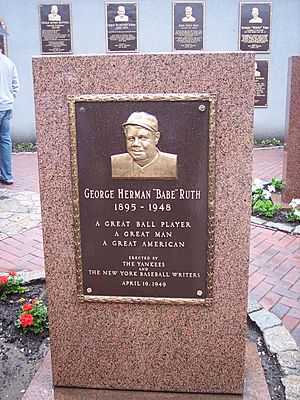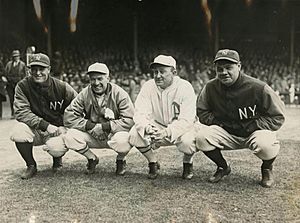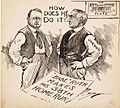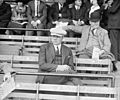Babe Ruth facts for kids
Quick facts for kids Babe Ruth |
|||
|---|---|---|---|
 |
|||
| Outfielder / Pitcher | |||
| Born: February 6, 1895 Baltimore, Maryland |
|||
| Died: August 16, 1948 (aged 53) New York, New York |
|||
|
|||
| debut | |||
| July 11, 1914, for the Boston Red Sox | |||
| Last appearance | |||
| May 30, 1935, for the Boston Braves | |||
| Career statistics | |||
| Batting average | .342 | ||
| Home runs | 714 | ||
| Hits | 2,873 | ||
| Runs batted in | 2,217 | ||
| Win–loss record | 94–46 | ||
| Earned run average | 2.28 | ||
| Teams | |||
|
|||
| Career highlights and awards | |||
MLB Records
|
|||
| Induction | 1936 | ||
| Vote | 95.13% | ||
George Herman "Babe" Ruth Jr. (born February 6, 1895 – died August 16, 1948) was a legendary American baseball player. He played in Major League Baseball from the 1910s to the 1930s. Babe Ruth played for the Boston Red Sox, New York Yankees, and the Boston Braves. He hit 714 home runs in his career. Only two players, Hank Aaron and Barry Bonds, have hit more.
At the start of his career, Ruth was an amazing pitcher. Later, he became famous for his powerful hitting. Many people consider him the greatest baseball player of all time.
| Top - 0-9 A B C D E F G H I J K L M N O P Q R S T U V W X Y Z |
Nicknames of Babe Ruth
Babe Ruth had many famous nicknames. Some of the most common names people called him were:
- "The Great Bambino"
- "The Sultan of Swat"
- "The Colossus of Clout"
- "The Titan of Terror"
- "The King Of Crash"
Babe Ruth's Early Life
George Herman Ruth Jr. was born in 1895 in Baltimore, Maryland. His parents, Katherine and George Herman Ruth Sr., were of German background. As a child, Ruth even spoke German.
When he was seven years old, Ruth was sent to St. Mary's Industrial School for Boys. This was a school and orphanage where he learned discipline. A person named Brother Matthias Boutlier, who was also a good baseball player, helped guide him.
Babe Ruth's Early Baseball Career
Babe Ruth's first team in Major League Baseball (MLB) was the Boston Red Sox. He started as a pitcher and was one of the best in baseball. The Red Sox won the World Series in 1915, 1916, and 1918 with Ruth on their team.
At that time, pitchers also got to hit the ball. The Red Sox soon realized that Ruth was incredibly good at hitting too. In 1918, he started hitting more and pitching less. Later in his career, he became an amazing outfielder.
Ruth quickly became a star player. However, in 1920, the Red Sox sold Ruth to the New York Yankees. They sold him for money. After this trade, the Red Sox did not win another World Series until 2004. Many baseball fans thought the Red Sox were "cursed" because they traded Ruth. They called this the "Curse of the Bambino."
After the Trade to the Yankees
Ruth spent most of his career with the Yankees. He became one of the most famous players in baseball history. Ruth helped the Yankees win World Series championships in 1923, 1927, 1928, and 1932. He left the Yankees after the 1934 season. He played his last season with the Boston Braves in 1935.
In 1927, Ruth hit 60 home runs. This was a new record for the most home runs in one season. Roger Maris broke this record in 1961 by hitting 61 home runs.
Babe Ruth's Retirement
After retiring from playing baseball, Babe Ruth enjoyed playing a lot of golf. He also played in a few special baseball games. Even after retirement, he could still attract huge crowds.
In 1938, the Dodgers hired him as a first base coach. Ruth wanted to play again as a pinch hitter, but his request was denied. He left his coaching job that same year. He never worked in baseball again after that.
During World War II, Ruth made many public appearances to support the war effort. He even played in a charity game at Yankee Stadium in 1943.
Babe Ruth's Death
In 1946, Ruth started having severe pain and trouble swallowing. Doctors found that he had an inoperable tumor. He received experimental treatments for his cancer.
In the summer of 1947, he seemed to get better for a while. On June 13, 1948, Ruth visited Yankee Stadium for the last time. He was there for the 25th anniversary of "The House that Ruth Built." By this time, he had lost a lot of weight and had trouble walking. He used a bat as a cane. A famous photo of Ruth, taken from behind, standing near home plate, won the Pulitzer Prize.
Ruth's health got worse. Many people, including children, waited outside the hospital during his final days. On August 16, 1948, Babe Ruth died in his sleep at age 53.
His funeral service lasted three days. His casket was placed in the rotunda of Yankee Stadium. About 77,000 people came to pay their respects. He was buried with his second wife, Claire, in Gate of Heaven Cemetery in Hawthorne, New York.
Memorials and Museums for Babe Ruth
On April 19, 1949, the Yankees put up a granite monument to honor Ruth at Yankee Stadium. This monument is now part of Monument Park at the new Yankee Stadium. The Yankees have also retired Ruth's uniform number 3.
The Babe Ruth Birthplace Museum is located at 216 Emory Street in Baltimore. This is the house where Ruth was born. It opened to the public in 1973. Ruth's wife, daughters, and sister helped choose items for the museum.
Babe Ruth's Impact on Baseball
Babe Ruth was the first baseball star to be loved so much by the public. His love for hitting home runs changed how baseball was played. Before 1920, home runs were not very common. Teams tried to score runs by getting players on base and moving them around with stolen bases or bunts. But when fans saw how exciting home runs were, the game changed.
Babe Ruth's Legacy
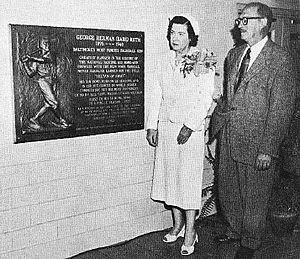
Babe Ruth is often called the greatest baseball player of all time in many surveys. In 1983, the United States Postal Service honored Ruth with a special twenty-cent stamp.
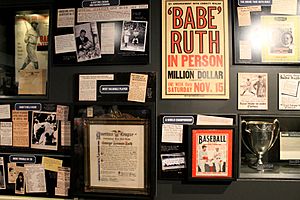
Some of the most expensive sports memorabilia ever sold are connected to Ruth. The bat he used to hit the first home run at Yankee Stadium sold for $1,265,000 in 2004.
The Baby Ruth candy bar might also be a long-lasting part of his fame. In 1995, Ruth's family allowed his image to be used for Baby Ruth ads. In 2005, the Baby Ruth bar became the official candy bar of Major League Baseball.
Interesting Facts about Babe Ruth
- Ruth learned how to be a shirtmaker and a carpenter at school. He even adjusted his own shirt collars during his baseball career.
- Ruth thought he was born on February 7, 1894. But he saw his birth certificate before a trip to Japan in 1934. It showed he was born on February 6, 1895.
- When he played baseball at school, he started as a catcher.
- He was one of the best left-handed pitchers ever.
- He was known as a home run hitter. He was one of only two players to hit 3 home runs in a World Series game.
- He was elected to the Baseball Hall of Fame in 1936.
- He is the only baseball player with the last name "Ruth" to play in a major league game.
- As of November 2016, Ruth's 1920 Yankees jersey was the most expensive piece of sports memorabilia ever sold. It sold for $4,415,658 in 2012!
- In December 2023, a Babe Ruth 1914 rookie card sold for $7.2 million.
Career Batting Statistics
| Season | G | AB | R | H | HR | RBI | BB | SO | Avg. | SLG |
|---|---|---|---|---|---|---|---|---|---|---|
| 1914 | 5 | 10 | 1 | 2 | 0 | 2 | 0 | 4 | .200 | .300 |
| 1915 | 42 | 92 | 16 | 29 | 4 | 21 | 9 | 23 | .315 | .576 |
| 1916 | 67 | 136 | 18 | 37 | 3 | 15 | 10 | 23 | .272 | .419 |
| 1917 | 52 | 123 | 14 | 40 | 2 | 12 | 12 | 18 | .325 | .472 |
| 1918 | 95 | 317 | 50 | 95 | 11 | 66 | 58 | 58 | .300 | .555 |
| 1919 | 130 | 432 | 103 | 139 | 29 | 114 | 101 | 58 | .322 | .657 |
| 1920 | 142 | 458 | 158 | 172 | 54 | 137 | 150 | 80 | .376 | .849 |
| 1921 | 152 | 540 | 177 | 204 | 59 | 171 | 145 | 81 | .378 | .846 |
| 1922 | 110 | 406 | 94 | 128 | 35 | 99 | 84 | 80 | .315 | .672 |
| 1923 | 152 | 522 | 151 | 205 | 41 | 131 | 170 | 93 | .393 | .764 |
| 1924 | 153 | 529 | 143 | 200 | 46 | 121 | 142 | 81 | .378 | .739 |
| 1925 | 98 | 359 | 61 | 104 | 25 | 66 | 59 | 68 | .290 | .543 |
| 1926 | 152 | 495 | 139 | 184 | 47 | 150 | 144 | 76 | .372 | .737 |
| 1927 | 151 | 540 | 158 | 192 | 60 | 164 | 137 | 89 | .356 | .772 |
| 1928 | 154 | 536 | 163 | 173 | 54 | 142 | 137 | 87 | .323 | .709 |
| 1929 | 135 | 499 | 121 | 172 | 46 | 154 | 72 | 60 | .345 | .697 |
| 1930 | 145 | 518 | 150 | 186 | 49 | 153 | 136 | 61 | .359 | .732 |
| 1931 | 145 | 534 | 149 | 199 | 46 | 163 | 128 | 51 | .373 | .700 |
| 1932 | 133 | 457 | 120 | 156 | 41 | 137 | 130 | 62 | .341 | .661 |
| 1933 | 137 | 459 | 97 | 138 | 34 | 103 | 114 | 90 | .301 | .582 |
| 1934 | 125 | 365 | 78 | 105 | 22 | 84 | 104 | 63 | .288 | .537 |
| 1935 | 28 | 72 | 13 | 13 | 6 | 12 | 20 | 24 | .181 | .431 |
| Career Statistics | 2,503 | 8,398 | 2,174 | 2,874 | 714 | 2,217 | 2,062 | 1,330 | .342 | .690 |
He also had a .474 career on-base percentage. This is the second highest of all time, just behind Ted Williams' .482.
Images for kids
-
"How Does He Do It?" In this Clifford Berryman cartoon, presidential candidates Warren G. Harding and James M. Cox wonder at Ruth's record home run pace.
-
Ruth after losing consciousness from running into the wall at Griffith Stadium during a game against the Washington Senators on July 5, 1924. Ruth insisted on staying in the game, despite evident pain and a bruised pelvic bone, and hit a double in his next at-bat. Note the absence of a warning track along the outfield wall.
-
Ruth took time off in 1927 to star with Anna Q. Nilsson in this First National silent production Babe Comes Home. This film is now lost.
-
Gary Cooper and Ruth in the 1942 film The Pride of the Yankees
See also
 In Spanish: Babe Ruth para niños
In Spanish: Babe Ruth para niños


